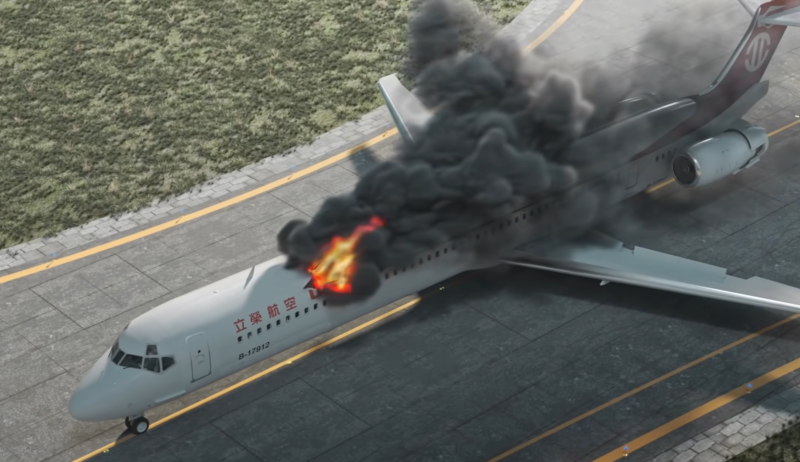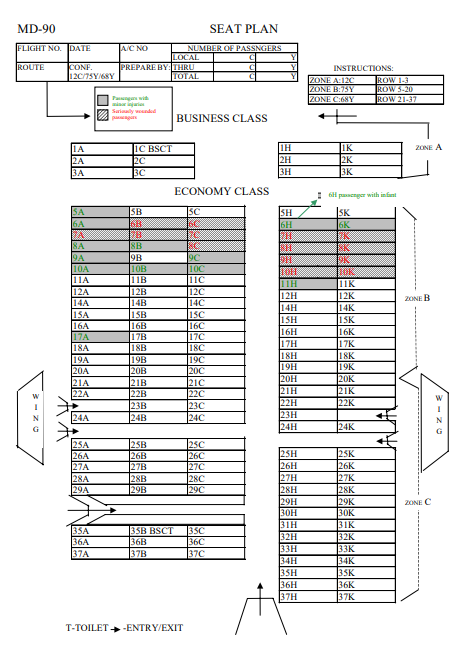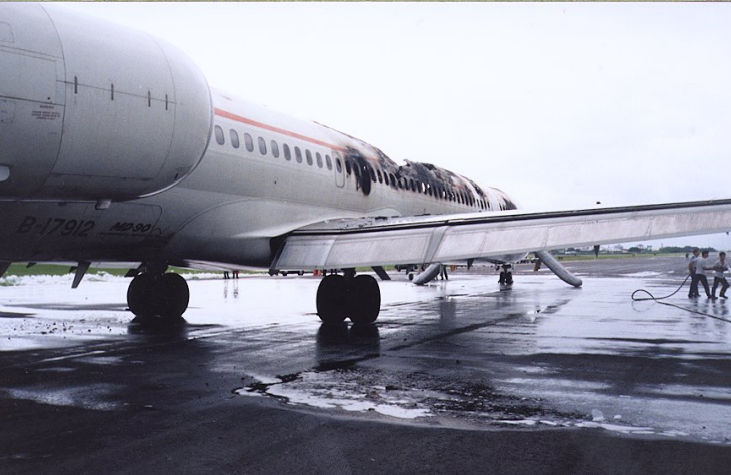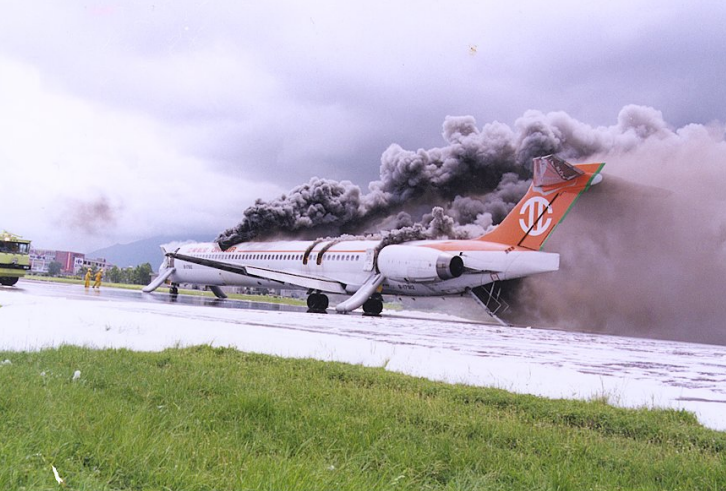On August 24, 1999, a Uni Air MD-90 was operating a domestic flight from Taipei to Hualien in Taiwan. However, shortly after landing in Hualien, a firey explosion broke out on board due to a leaking plastic bottle containing gasoline. As a result, Uni Air Flight 873 marked the first and only hull loss of the McDonnell Douglas MD-90.
Flight Details
The McDonnell Douglas MD-90 with registration B-17912 was operating Uni Air Flight UIA 873, from Taipei-Songshan Airport, Taiwan to Hualien Airport. Flight UIA 873 was under the command of a captain who had 6532 hours in his logbook, including 1,205 hours in the MD 90. He was accompanied by his first officer, who had 5,167 flight hours including about 100 hours on this type. Onboard the flight were four flight attendants and 90 passengers.
Flight UIA 873 continued uneventfully, with no irregularities at any point during the flight, from the moment of takeoff up until landing. Every detail of the flight, starting with the backup, taxing and takeoff from Taipei and its climb, cruising, descending, approach and landing went normal.
However, as the MD-90 touched down following a 25-minute flight from Taipei and was rolling on Runway 21 at the Hualien Airport, an explosion occurred in the front section of the passenger cabin. Following the explosion, thick black smoke poured from one of the overhead luggage compartments on the right-hand side of the plane.
The explosion took place at 12:36 pm local time and the pilots immediately applied the brakes and brought the aircraft to a stop on the runway. After lowering the passenger evacuation slides and initiating an emergency passenger evacuation, the pilot called the tower for help.

Tower: UNI873, this is Tower. Do you have any problem? Please remain where you are.
UNI Flight 873: Mayday! Mayday! Mayday!
Tower: Fire engine! This is Tower.
Fire engine: Fire engine copy, fire engine standby on the ramp.
Tower: Fire engine! Go to Opening 2, UNI flight is at Opening 2.
Fire engine: Fire engine Roger!
Fire squads at both the Hualien Airport and the Air Force Wing rushed to the scene to extinguish the fire, which was eventually put out at 1:45 pm.
Evacuation, Fatality and Injuries
Despite the upper part of the fuselage being completely destroyed by the fire, all 90 passengers and the six crew members were safely evacuated. However, 14 passengers suffered serious injuries, while another 14 had minor injuries. Most of the injured passengers suffered burns, and one passenger was struck by fragments from the explosion.
Ku Jing-chi, a passenger and the brother of a former Taiwanese decathlete had serious injuries and died 47 days after the accident, while another female passenger seated in 8H suffered a facial fracture, a head injury and a haemorrhage in her skull. Also, she suffered a miscarriage at 26 weeks. She suffered from shock and was found unconscious.
The deceased passenger had been seated in 7B. He died due to the 2nd and 3rd degree burns sustained on over 45% of his body, which resulted in poisonous blood and eventually cardiopulmonary failure. Two more passengers seated in 7C and 7A suffered 2nd and 3rd-degree burns over 20% of their bodies, as well as injuries from smoke inhalation.

Aircraft Damage and Findings
The majority of the aircraft’s interior decoration was consumed by fire. While the seats in rows 5, 6, and 7 and a few others in the tail section, were found to be intact, nearly all other seats were severely damaged, along with the fuselage and upper system wiring.
Moreover, the upper part of the fuselage was totally destroyed. Several fragments from the explosion were found in the left-side engine. However, the main framework, the wings, the engines and the auxiliary power units remained intact. The fire completely destroyed most of the seats from the back of the seat to the fuselage, except for a few rows. Furthermore, all of the windows, with the exception of a few rows, were destroyed.
Overall, the aircraft was deemed to be a Hull loss due to the extent of the damage it sustained. Uni Air Flight 873 was The McDonnell Douglas MD-90’s First and Only Hull loss.
The Aviation Safety Council established an Accident Investigation Team to investigate the accident, and the team was led by Mr Alfred Dickinson of the U.S. National Transportation Safety Board (NTSB). The other team members were also from the NTSB, the Federal Aviation Administration (FAA), and the Boeing Company.

Initial investigations found that the explosion was caused by a leak in a plastic bottle containing gasoline, which resulted in the evaporation of gasoline fumes in the air. When the vapour concentration reached the lower limit of the explosion, the spark energy generated by the 12V motorcycle battery in an instant short circuit triggered the explosion. Further investigation revealed that the flammable liquid was gasoline inside bleach and softener bottles sealed with silicone that was carried on board the aircraft.
The investigation confirmed that the explosion was not solely related to aviation safety. The accident was caused by the transportation of flammable liquid, gasoline, in bleach and softener bottles sealed with silicone. A combustible vapour formed as the leaking gasoline filled the stowage bin, and the impact of the landing aircraft caused the battery to short. The short ignited the gasoline vapour and created the explosion.
The Aviation Safety Council investigation identified the following contributing factors:
1. The Civil Aeronautical Administration Organic Regulations and its operational bylaws’ failure to designate any entity as responsible for hazardous materials.
2. The Aviation Police failed to properly recruit and train personnel, including preparing training materials and evaluating training performance. Some new recruits were found to have not received any formal security check training, but instead were following instructions from senior inspectors. Consequently, new inspectors cannot be relied upon to identify hazardous materials.
3. The detectors and inspectors failed to detect the hazardous materials. The detectors used by the Aviation Police did not detect the banned motorcycle batteries, nor did security inspectors detect the liquid bleach, a banned corrosive substance.
Aftermath
Based on the findings of the investigation, the Aviation Safety Council made several recommendations to improve flight safety. This investigation led to the formulation of safety recommendations for several organizations including UNI Air, the Aviation Police Bureau of the National Police Administration and the Civil Aeronautical Administration of Taiwan.
According to the report from the Aviation Safety Council, it was revealed that the former Taiwanese decathlete named Ku Chin-Shui had provided his nephew with two bottles of gasoline to carry on board the flight. As a result, Ku was sentenced to ten years in prison after the incident went to court, which was later reduced to seven and a half years. However, during a fifth retrial, Ku was found not guilty due to the discovery of other materials from the plane testing positive for gasoline.
The investigation and subsequent safety recommendations have contributed to improving aviation safety and preventing similar incidents from occurring in the future.
Feature Image via Aviation Safety Council


